Impact of Polymer Physicochemical Features on the Amorphization and Crystallization of Citric Acid in Solid Dispersions
Abstract
1. Introduction
2. Materials and Methods
2.1. Materials
2.2. Formation of Solid Dispersions via Lyophilization
2.3. Storage Treatments
2.4. Powder X-Ray Diffraction (PXRD)
2.5. Fourier Transform Infrared Spectroscopy (FTIR)
2.6. Moisture Sorption Isotherm Analysis
2.7. Differential Scanning Calorimetry (DSC)
2.8. Statistical Analysis
3. Results and Discussion
3.1. Long Term Physical Stability of Citric Acid Amorphous Solid Dispersions Towards Crystallization Measured by PXRD
3.2. FTIR Spectroscopic Investigation of Interactions Between Citric Acid and Polymers
3.3. Potential Ionic Interaction Between Citric Acid and Select Polymers
3.4. Moisture Sorption Isotherm Profiles
3.5. Glass Transition Temperatures
4. Conclusions
Supplementary Materials
Author Contributions
Funding
Institutional Review Board Statement
Data Availability Statement
Acknowledgments
Conflicts of Interest
References
- Lambros, M.; Tran, T.; Fei, Q.; Nicolaou, M. Citric Acid: A Multifunctional Pharmaceutical Excipient. Pharmaceutics 2022, 14, 972. [Google Scholar] [CrossRef] [PubMed]
- Książek, E. Citric Acid: Properties, Microbial Production, and Applications in Industries. Molecules 2024, 29, 22. [Google Scholar] [CrossRef] [PubMed]
- Jozinović, A.; Kovač, M.; Ocelić Bulatović, V.; Kučić Grgić, D.; Miloloža, M.; Šubarić, D.; Ačkar, Đ. Biopolymeric Blends of Thermoplastic Starch and Polylactide as Sustainable Packaging Materials. Polymers 2024, 16, 1268. [Google Scholar] [CrossRef] [PubMed]
- Camaño Erhardt, M.; Solier, Y.N.; Inalbon, M.C.; Mocchiutti, P. Tuning the Properties of Xylan/Chitosan-Based Films by Temperature and Citric Acid Crosslinking Agent. Polymers 2024, 16, 2407. [Google Scholar] [CrossRef] [PubMed]
- Pažarauskaitė, A.; Noriega Fernández, E.; Sone, I.; Sivertsvik, M.; Sharmin, N. Combined Effect of Citric Acid and Polyphenol-Rich Grape Seed Extract towards Bioactive Smart Food Packaging Systems. Polymers 2023, 15, 3118. [Google Scholar] [CrossRef] [PubMed]
- Khadsai, S.; Janmanee, R.; Sam-Ang, P.; Nuanchawee, Y.; Rakitikul, W.; Mankhong, W.; Likittrakulwong, W.; Ninjiaranai, P. Influence of Crosslinking Concentration on the Properties of Biodegradable Modified Cassava Starch-Based Films for Packaging Applications. Polymers 2024, 16, 1647. [Google Scholar] [CrossRef] [PubMed]
- Taboun, A.; Jovanovic, M.; Petrovic, M.; Stajcic, I.; Pesic, I.; Stojanovic, D.B.; Radojevic, V. Citric Acid Cross-Linked Gelatin-Based Composites with Improved Microhardness. Polymers 2024, 16, 1077. [Google Scholar] [CrossRef] [PubMed]
- Ćorović, M.; Petrov Ivanković, A.; Milivojević, A.; Veljković, M.; Simović, M.; López-Revenga, P.; Montilla, A.; Moreno, F.J.; Bezbradica, D. Valorisation of Blackcurrant Pomace by Extraction of Pectin-Rich Fractions: Structural Characterization and Evaluation as Multifunctional Cosmetic Ingredient. Polymers 2024, 16, 2779. [Google Scholar] [CrossRef] [PubMed]
- Alhamhoom, Y.; Said, A.K.; Kumar, A.; Nanjappa, S.H.; Wali, D.; Rahamathulla, M.; Farhana, S.A.; Ahmed, M.M.; Shivanandappa, T.B. Sublingual Fast-Dissolving Thin Films of Loratadine: Characterization, In Vitro and Ex Vivo Evaluation. Polymers 2024, 16, 2919. [Google Scholar] [CrossRef]
- Chuysinuan, P.; Pengsuk, C.; Lirdprapamongkol, K.; Thanyacharoen, T.; Techasakul, S.; Svasti, J.; Nooeaid, P. Turmeric Herb Extract-Incorporated Biopolymer Dressings with Beneficial Antibacterial, Antioxidant and Anti-Inflammatory Properties for Wound Healing. Polymers 2023, 15, 1090. [Google Scholar] [CrossRef]
- Hoti, G.; Ferrero, R.; Caldera, F.; Trotta, F.; Corno, M.; Pantaleone, S.; Desoky, M.M.H.; Brunella, V. A Comparison between the Molecularly Imprinted and Non-Molecularly Imprinted Cyclodextrin-Based Nanosponges for the Transdermal Delivery of Melatonin. Polymers 2023, 15, 1543. [Google Scholar] [CrossRef] [PubMed]
- O-Chongpian, P.; Na Takuathung, M.; Chittasupho, C.; Ruksiriwanich, W.; Chaiwarit, T.; Baipaywad, P.; Jantrawut, P. Composite Nanocellulose Fibers-Based Hydrogels Loading Clindamycin Hcl with Ca2+ and Citric Acid as Crosslinking Agents for Pharmaceutical Applications. Polymers 2021, 13, 4423. [Google Scholar] [CrossRef]
- Hancock, B.C.; Zografi, G. Characteristics and Significance of the Amorphous State in Pharmaceutical Systems. J. Pharm. Sci. 1997, 86, 1–12. [Google Scholar] [CrossRef]
- Arioglu-Tuncil, S.; Voelker, A.L.; Taylor, L.S.; Mauer, L.J. Amorphization of Thiamine Mononitrate: A Study of Crystallization Inhibition and Chemical Stability of Thiamine in Thiamine Mononitrate Amorphous Solid Dispersions. Int. J. Mol. Sci. 2020, 21, 9370. [Google Scholar] [CrossRef]
- Arioglu-Tuncil, S.; Voelker, A.L.; Taylor, L.S.; Mauer, L.J. Amorphization of Thiamine Chloride Hydrochloride: Effects of Physical State and Polymer Type on the Chemical Stability of Thiamine in Solid Dispersions. Int. J. Mol. Sci. 2020, 21, 5935. [Google Scholar] [CrossRef]
- Ribeiro, A.P.B.; Masuchi, M.H.; Miyasaki, E.K.; Domingues, M.A.F.; Stroppa, V.L.Z.; de Oliveira, G.M.; Kieckbusch, T.G. Crystallization Modifiers in Lipid Systems. J. Food Sci. Technol. 2015, 52, 3925–3946. [Google Scholar] [CrossRef]
- Ambike, A.A.; Mahadik, K.R.; Paradkar, A. Spray-Dried Amorphous Solid Dispersions of Simvastatin, a Low Tg Drug: In Vitro and in Vivo Evaluations. Pharm. Res. 2005, 22, 990–998. [Google Scholar] [CrossRef]
- Kim, M.S.; Jin, S.J.; Kim, J.S.; Park, H.J.; Song, H.S.; Neubert, R.H.H.; Hwang, S.J. Preparation, Characterization and in Vivo Evaluation of Amorphous Atorvastatin Calcium Nanoparticles Using Supercritical Antisolvent (SAS) Process. Eur. J. Pharm. Biopharm. 2008, 69, 454–465. [Google Scholar] [CrossRef] [PubMed]
- Law, D.; Schmitt, E.A.; Marsh, K.C.; Everitt, E.A.; Wang, W.; Fort, J.J.; Krill, S.L.; Qiu, Y. Ritonavir-PEG 8000 Amorphous Solid. Dispersions: In Vitro and In Vivo Evaluations. J. Pharm. Sci. 2004, 93, 563–570. [Google Scholar] [CrossRef]
- Roy, L.; Lipert, M.P.; Rodríguez-Hornedo, N. Co-Crystal Solubility and Thermodynamic Stability. In Pharmaceutical Salts and Co-Crystals; The Royal Society of Chemistry: London, UK, 2011; pp. 247–279. [Google Scholar]
- Allan, M.; Mauer, L.J. RH-Temperature Phase Diagrams of Hydrate Forming Deliquescent Crystalline Ingredients. Food Chem. 2017, 236, 21–31. [Google Scholar] [CrossRef]
- Chiou, W.L.; Riegelman, S. Preparation and Dissolution Characteristics of Several Fast-Release Solid Dispersions of Griseofulvin. J. Pharm. Sci. 1969, 58, 1505–1510. [Google Scholar] [CrossRef]
- Hoppu, P.; Hietala, S.; Schantz, S.; Juppo, A. Rheology and Molecular Mobility of Amorphous Blends of Citric Acid and Paracetamol. Eur. J. Pharm. Biopharm. 2009, 71, 55–63. [Google Scholar] [CrossRef]
- Hoppu, P.; Jouppila, K.; Rantanen, J.; Schantz, S.; Juppo, A.M. Characterisation of Blends of Paracetamol and Citric Acid. J. Pharm. Pharmacol. 2007, 59, 373–381. [Google Scholar] [CrossRef] [PubMed]
- Lu, Q.; Zografi, G. Properties of Citric Acid at the Glass Transition. J. Pharm. Sci. 1997, 86, 1374–1378. [Google Scholar] [CrossRef] [PubMed]
- Lu, Q.; Zografi, G. Phase Behavior of Binary and Ternary Amorphous Mixtures Containing Indomethacin, Citric Acid, and PVP. Pharm. Res. 1998, 15, 1202–1206. [Google Scholar] [CrossRef]
- Summers, M.P. Glass Formation in Barbiturates and Solid Dispersion Systems of Barbiturates with Citric Acid. J. Pharm. Sci. 1978, 67, 1606–1610. [Google Scholar] [CrossRef] [PubMed]
- Summers, M.P.; Enever, R.P. Preparation and Properties of Solid Dispersion System Containing Citric Acid and Primidone. J. Pharm. Sci. 1976, 65, 1613–1617. [Google Scholar] [CrossRef] [PubMed]
- Timko, R.J.; Lordi, N.G. Thermal Characterization of Citric Acid Solid Dispersions with Benzoic Acid and Phenobarbital. J. Pharm. Sci. 1979, 68, 601–605. [Google Scholar] [CrossRef]
- Yoshioka, M.; Hancock, B.C.; Zografi, G. Crystallization of Indomethacin from the Amorphous State below and above Its Glass Transition Temperature. J. Pharm. Sci. 1994, 83, 1700–1705. [Google Scholar] [CrossRef] [PubMed]
- Chiou, W.L.; Riegelman, S. Pharmaceutical Applications of Solid Dispersion Systems. J. Pharm. Sci. 1971, 60, 1281–1302. [Google Scholar] [CrossRef] [PubMed]
- Wang, J.; Chang, R.; Zhao, Y.; Zhang, J.; Zhang, T.; Fu, Q.; Chang, C.; Zeng, A. Coamorphous Loratadine-Citric Acid System with Enhanced Physical Stability and Bioavailability. AAPS PharmSciTech 2017, 18, 2541–2550. [Google Scholar] [CrossRef] [PubMed]
- Wegiel, L.A.; Zhao, Y.; Mauer, L.J.; Edgar, K.J.; Taylor, L.S. Curcumin Amorphous Solid Dispersions: The Influence of Intra and Intermolecular Bonding on Physical Stability. Pharm. Dev. Technol. 2014, 19, 976–986. [Google Scholar] [CrossRef]
- Arioglu-Tuncil, S.; Bhardwaj, V.; Taylor, L.S.; Mauer, L.J. Amorphization of Thiamine Chloride Hydrochloride: A Study of the Crystallization Inhibitor Properties of Different Polymers in Thiamine Chloride Hydrochloride Amorphous Solid Dispersions. Food Res. Int. 2017, 99, 363–374. [Google Scholar] [CrossRef] [PubMed]
- Christina, B.; Taylor, L.S.; Mauer, L.J. Physical Stability of L-Ascorbic Acid Amorphous Solid Dispersions in Different Polymers: A Study of Polymer Crystallization Inhibitor Properties. Food Res. Int. 2015, 76, 867–877. [Google Scholar] [CrossRef] [PubMed]
- Wegiel, L.A.; Mauer, L.J.; Edgar, K.J.; Taylor, L.S. Crystallization of Amorphous Solid Dispersions of Resveratrol during Preparation and Storage-Impact of Different Polymers. J. Pharm. Sci. 2013, 102, 171–184. [Google Scholar] [CrossRef] [PubMed]
- Sanchez, J.O.; Ismail, Y.; Christina, B.; Mauer, L.J. Degradation of L-Ascorbic Acid in the Amorphous Solid State. J. Food Sci. 2018, 83, 670–681. [Google Scholar] [CrossRef] [PubMed]
- Kadoya, S.; Izutsu, K.-I.; Yonemochi, E.; Terada, K.; Yomota, C.; Kawanishi, T. Glass-State Amorphous Salt Solids Formed by Freeze-Drying of Amines and Hydroxy Carboxylic Acids: Effect of Hydrogen-Bonding and Electrostatic Interactions. Chem. Pharm. Bull. 2008, 56, 821–826. [Google Scholar] [CrossRef][Green Version]
- Franks, F.; Auffret, T. Primary Drying: The Sublimation of Ice. In Freeze-Drying of Pharmaceuticals and Biopharmaceuticals; The Royal Society of Chemistry: London, UK, 2007; pp. 105–120. [Google Scholar]
- Socrates, G. The Carbonyl Group: C=O. In Infrared and Raman Characteristic Group. Frequencies: Tables and Figures; John Wiley & Sons: Hoboken, NJ, USA, 2001; pp. 115–156. [Google Scholar]
- Glusker, J.P.; Minkin, J.A.; Patterson, A.L. X-Ray Crystal Analysis of the Substrates of Aconitase. IX. A Refinement of the Structure of Anhydrous Citric Acid. Acta Crystallogr. B 1969, 25, 1066–1072. [Google Scholar] [CrossRef] [PubMed]
- Nordman, C.E.; Weldon, A.S.; Patterson, A.L. X-Ray Crystal Analysis of the Substrates of Aconitase. II. Anhydrous Citric Acid. Acta Crystallogr. 1960, 13, 418–426. [Google Scholar] [CrossRef]
- Bichara, L.C.; Lanús, H.E.; Ferrer, E.G.; Gramajo, M.B.; Brandán, S.A. Vibrational Study and Force Field of the Citric Acid Dimer Based on the SQM Methodology. Adv. Phys. Chem. 2011, 2011, 347072. [Google Scholar] [CrossRef]
- Laurence, C.; Brameld, K.A.; Graton, J.; Le Questel, J.Y.; Renault, E. The PKBHX Database: Toward a Better Understanding of Hydrogen-Bond Basicity for Medicinal Chemists. J. Med. Chem. 2009, 52, 4073–4086. [Google Scholar] [CrossRef] [PubMed]
- Apelblat, A. Dissociation Equilibria in Solutions with Citrate Ions. In Citric Acid; Springer International Publishing: Cham, Switzlerland, 2014; pp. 143–212. [Google Scholar]
- Einhorn-Stoll, U. Pectin-Water Interactions in Foods—From Powder to Gel. Food Hydrocoll. 2018, 78, 109–119. [Google Scholar] [CrossRef]
- Etter, M.C. Encoding and Decoding Hydrogen-Bond Patterns of Organic Compounds. Acc. Chem. Res. 1990, 23, 120–126. [Google Scholar] [CrossRef]
- Salameh, A.K.; Mauer, L.J.; Taylor, L.S. Deliquescence Lowering in Food Ingredient Mixtures. J. Food Sci. 2006, 71. [Google Scholar] [CrossRef]
- Mauer, L.J.; Taylor, L.S. Water-Solids Interactions: Deliquescence. Annu. Rev. Food Sci. Technol. 2010, 1, 41–63. [Google Scholar] [CrossRef] [PubMed]
- Bochek, A.M.; Shevchuk, I.L.; Gavrilova, I.I.; Nesterova, N.A.; Panarin, E.F.; Yudin, V.E.; Lebedeva, M.F.; Popova, E.N.; Kalyuzhnaya, L.M.; Volchek, B.Z.; et al. Compatibility of Carboxymethyl Cellulose Ionized to Various Degrees with Poly-n-Vinylformamide in Composite Films. Russ. J. Appl. Chem. 2012, 85, 1413–1421. [Google Scholar] [CrossRef]
- Mahmood, W.; Mizanur Rahman Khan, M.; Yee Teow, C. Effects of Reaction Temperature on the Synthesis and Thermal Properties of Carrageenan Ester. J. Phys. Sci. 2014, 25, 123. [Google Scholar]
- Kumar, A.; De, A.; Mozumdar, S. Synthesis of Acrylate Guar-Gum for Delivery of Bio-Active Molecules. Bull. Mater. Sci. 2015, 38, 1025–1032. [Google Scholar] [CrossRef]
- Van Den Mooter, G.; Wuyts, M.; Blaton, N.; Busson, R.; Grobet, P.; Augustijns, P.; Kinget, R. Physical Stabilisation of Amorphous Ketoconazole in Solid Dispersions with Polyvinylpyrrolidone K25. Eur. J. Pharm. Sci. 2001, 12, 261–269. [Google Scholar] [CrossRef]
- Sugisaki, M.; Suga, H.; Seki, S. Calorimetric Study of the Glassy State. IV. Heat Capacities of Glassy Water and Cubic Ice. Bull. Chem. Soc. Jpn. 1968, 41, 2591–2599. [Google Scholar] [CrossRef]
- Fox, T.G. Influence of Diluent and of Copolymer Composition on the Glass Temperature of a Polymer System. Bull. Am. Phys. Soc. 1956, 1, 123–135. [Google Scholar]
- Gordon, M.; Taylor, J.S. Ideal Copolymers and the Second-order Transitions of Synthetic Rubbers. i. Non-crystalline Copolymers. J. Appl. Chem. 1952, 2, 493–500. [Google Scholar] [CrossRef]
- Taylor, L.S.; Zografi, G. Spectroscopic Characterization of Interactions between PVP and Indomethacin in Amorphous Molecular Dispersions. Pharm. Res. 1997, 14, 1691–1698. [Google Scholar] [CrossRef] [PubMed]

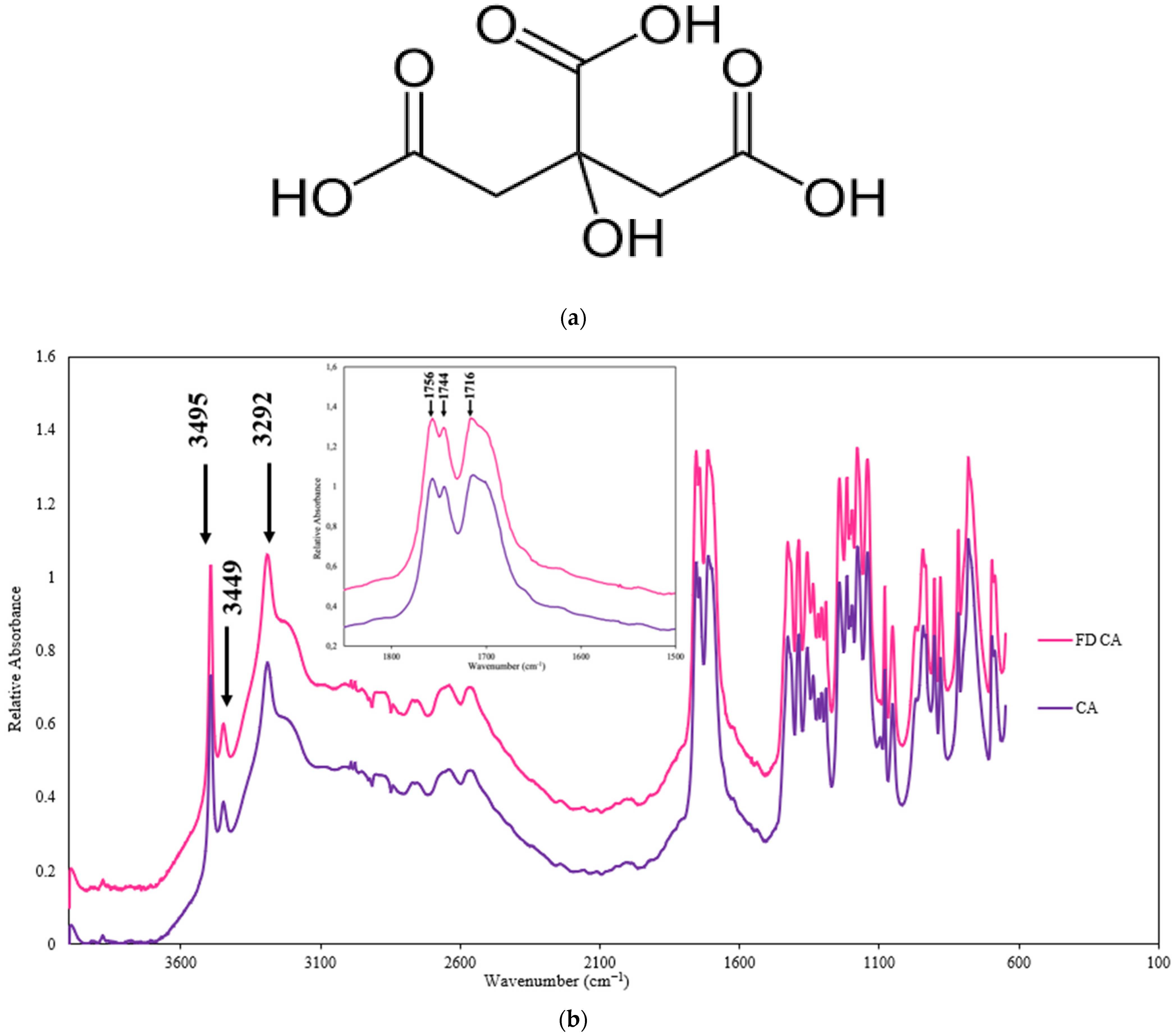
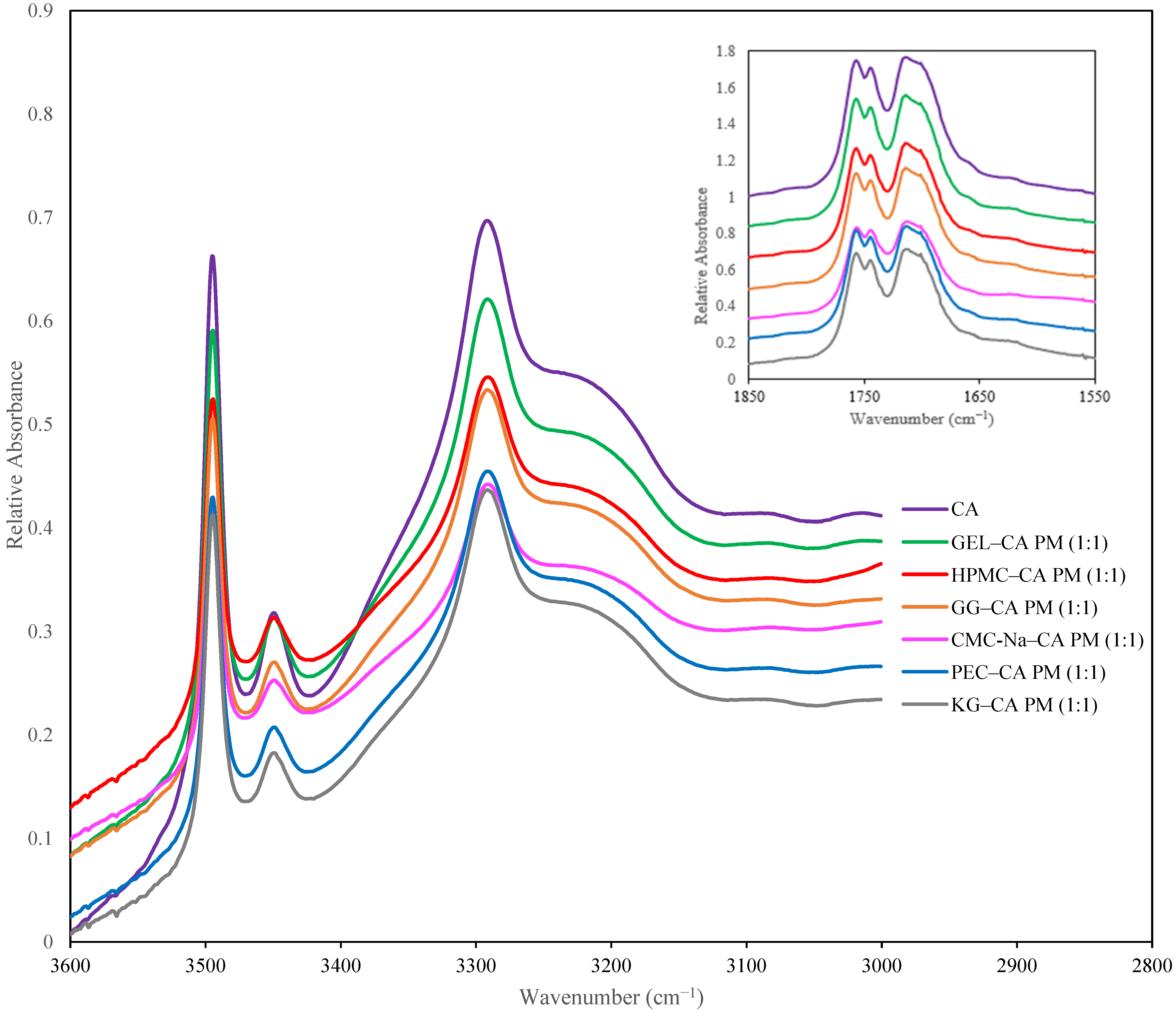
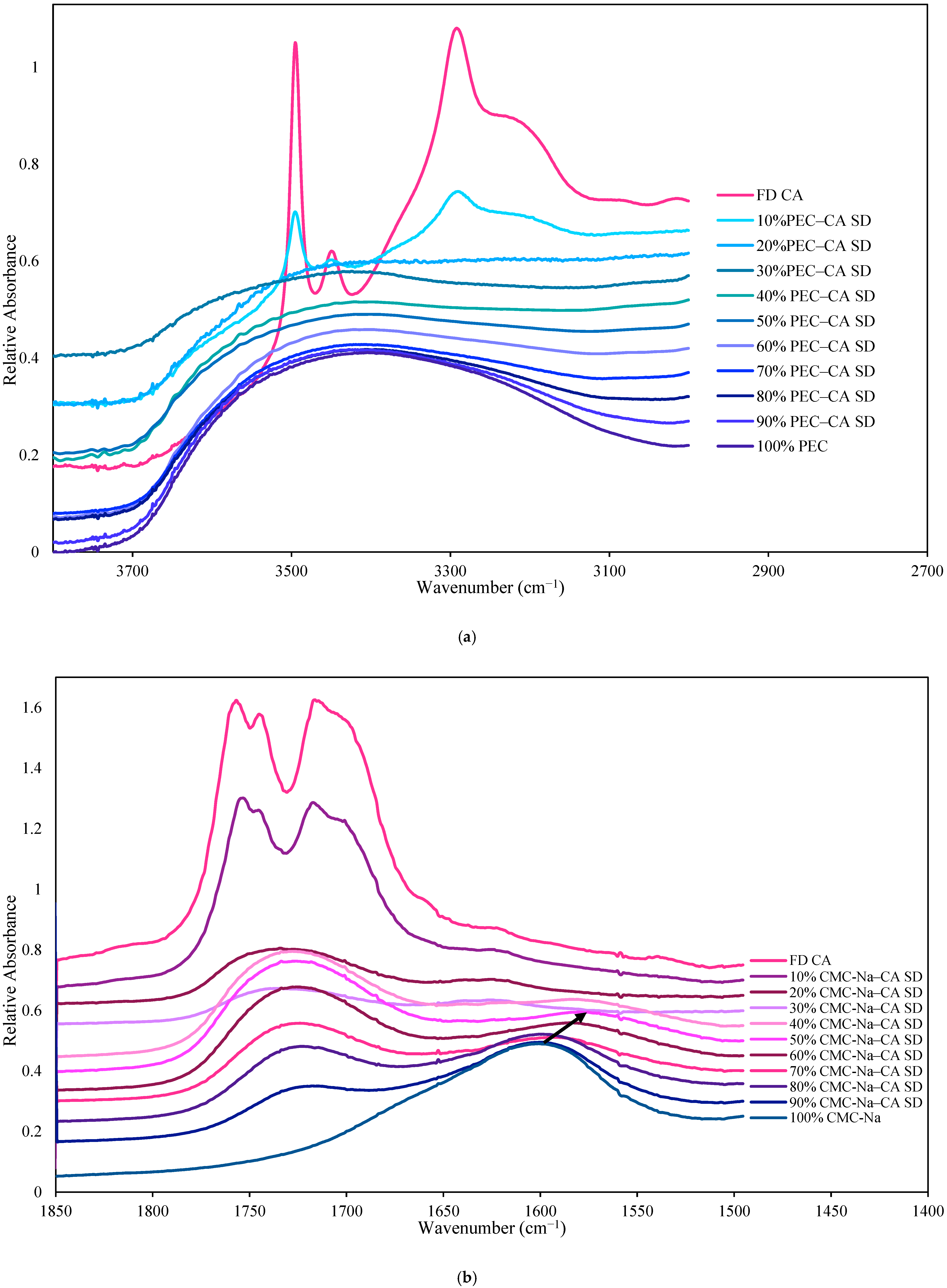

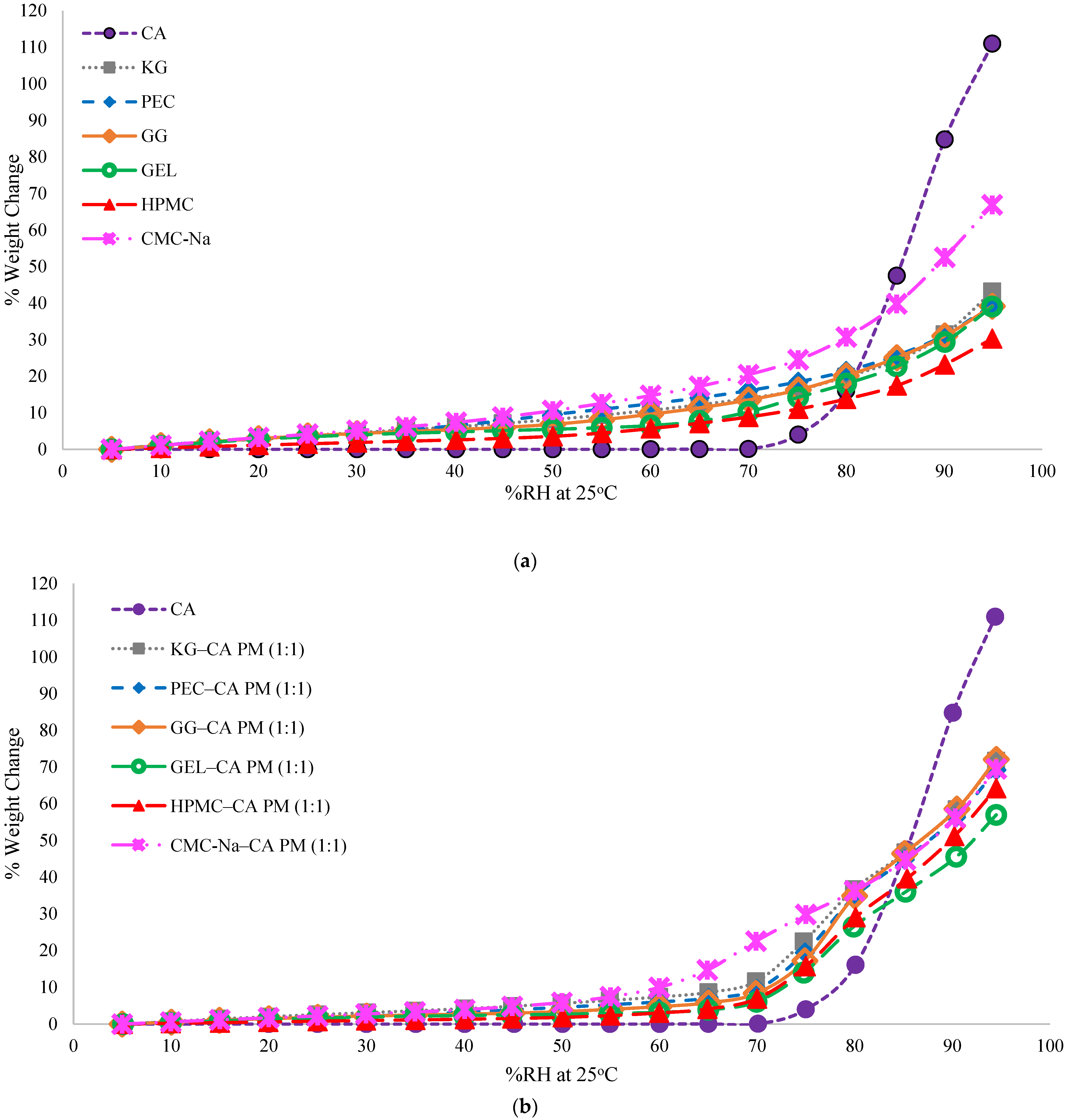


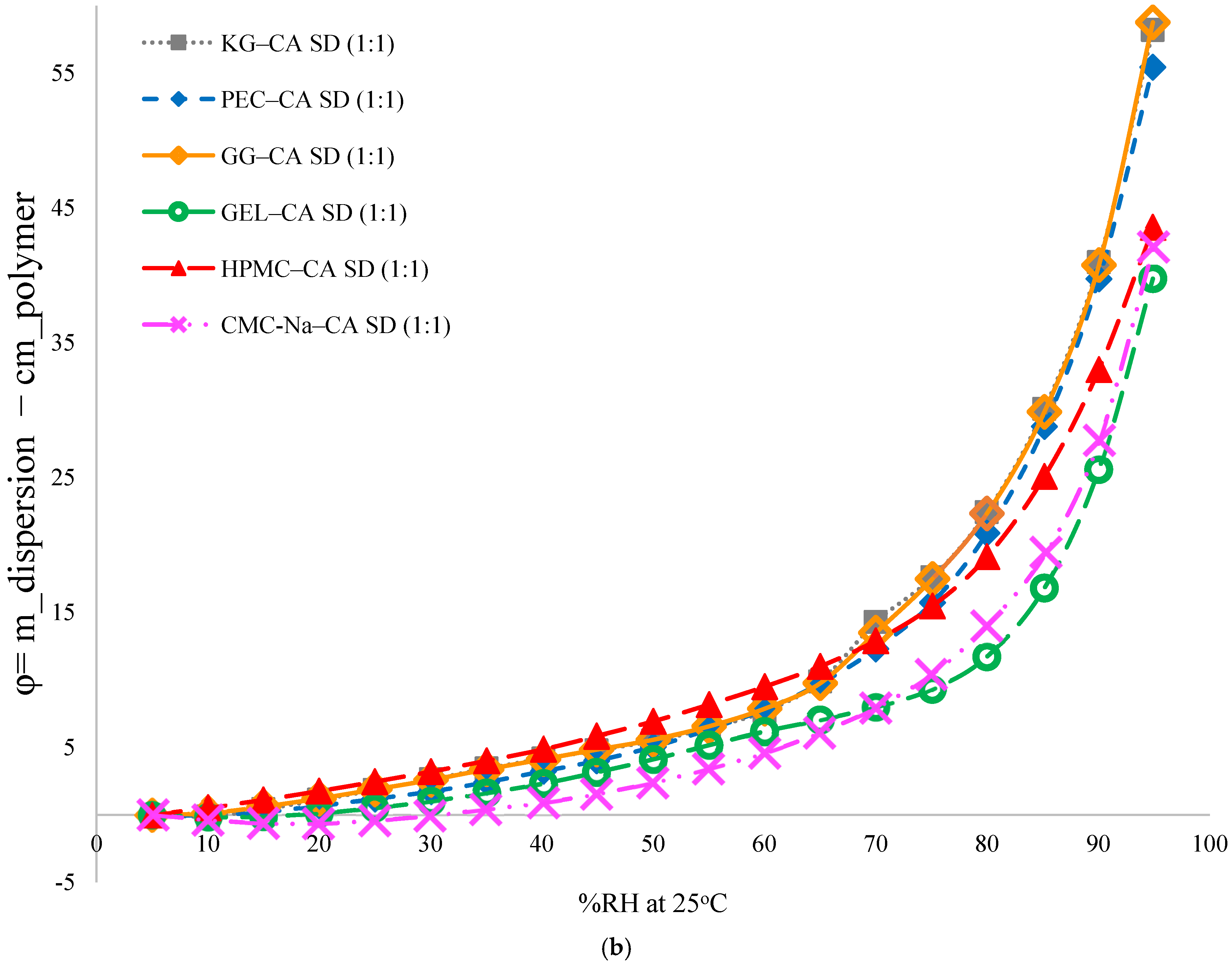
| RH (%) and T (°C) | CA–CMC-Na SD | CA–PEC SD | CA–GEL SD | CA–HPMC SD | CA–GG SD | CA–KG SD |
|---|---|---|---|---|---|---|
| 0% RH- 25 °C | >189-A | >189-A | >189-A | >189-A | >189-A | >189-A |
| 0% RH- 40 °C | >189-A | >189-A | >189-A | >189-A | >189-A | >189-A |
| 32% RH- 25 °C | >189-A | >189-A | >189-A | >189-A | >189-A | <21-C |
| 32% RH- 40 °C | >189-A | >189-A | <63-PC | <28-PC | <28-PC | <21-C |
| 54% RH- 25 °C | <63-PC | <21-C | <49-C | <21-C | <14-C | <14-C |
| 54% RH- 40 °C | <49-C | <21-C | <49-C | <21-C | <14-C | <14-C |
| Compound | Hydrogen Bond Donor | Hydrogen Bond Acceptor | ||
|---|---|---|---|---|
| Group | Strength | Group | Strength a | |
| CA | Hydroxyl | Strong | Hydroxyl | Medium |
| Carboxylic | Very Strong | Carboxylic | Medium b | |
| PEC | Hydroxyl | Strong | Hydroxyl | Medium |
| Carboxylic | Very Strong | Carboxylic | Medium b | |
| Ether | Medium | |||
| Ester | Medium | |||
| GG | Hydroxyl | Strong | Hydroxyl | Medium |
| Ether | Medium | |||
| KG | Hydroxyl | Strong | Hydroxyl | Medium |
| Ether | Medium | |||
| S=O of sulfate ester | Medium | |||
| HPMC | Hydroxyl | Strong | Hydroxyl | Medium |
| Ether | Medium | |||
| CMC-Na | Hydroxyl | Strong | Hydroxyl | Medium |
| Carboxylic | Very Strong | Carboxylic Ether | Medium Medium | |
| CA–Polymer Dispersion | %CA | Hydroxyl Region (3600–3000 cm−1) | Total Shift | Carbonyl Region (1800–1500 cm−1) | Total Shift | ||
|---|---|---|---|---|---|---|---|
| CA–PEC | 0 → 50 | 3419 → 3400 | 19 | 1743 → 1734 | 1622 → 1647 | 9 | −25 |
| CA–KG | 0 → 50 | 3422 → 3384 | 38 | N/A | |||
| CA–GG | 0 → 50 | 3388 → 3402 | −14 | N/A | |||
| CA–GEL | 0 → 50 | 3322 → 3335 | −12 | 1653 → 1634 | 1558 → 1546 | 19 | 12 |
| CA–HPMC | 0 → 50 | 3461 → 3421 | 40 | N/A | |||
| CA–CMC-Na | 0 → 50 | 3400 → 3400 | 0 | 1600 → 1575 | 25 | ||
| Dispersion Type | Onset Tg (°C) at (°C) Day 0 (Pin Hole) | Onset Tg (°C) at Day 0 (No Pin Hole) |
|---|---|---|
| CMC-Na–CA SD | 49.5 ± 1.1 A | 14.3 a |
| GEL–CA SD | 44.4 ± 1.3 A | 13.1 ± 2.5 a |
| GG–CA SD | 21.8 ± 2.4 DC | −9.5 ± 1.8 b |
| HPMC–CA SD | 16.6 ± 1.8 D | −7.8 b |
| KG–CA SD | 24.7 ± 0.2 C | −10.4 ± 0.1 b |
| PEC–CA SD | 33.5 ± 0.8 B | −5.7 ± 0.2 b |
Disclaimer/Publisher’s Note: The statements, opinions and data contained in all publications are solely those of the individual author(s) and contributor(s) and not of MDPI and/or the editor(s). MDPI and/or the editor(s) disclaim responsibility for any injury to people or property resulting from any ideas, methods, instructions or products referred to in the content. |
© 2025 by the authors. Licensee MDPI, Basel, Switzerland. This article is an open access article distributed under the terms and conditions of the Creative Commons Attribution (CC BY) license (https://creativecommons.org/licenses/by/4.0/).
Share and Cite
Arioglu-Tuncil, S.; Mauer, L.J. Impact of Polymer Physicochemical Features on the Amorphization and Crystallization of Citric Acid in Solid Dispersions. Polymers 2025, 17, 310. https://doi.org/10.3390/polym17030310
Arioglu-Tuncil S, Mauer LJ. Impact of Polymer Physicochemical Features on the Amorphization and Crystallization of Citric Acid in Solid Dispersions. Polymers. 2025; 17(3):310. https://doi.org/10.3390/polym17030310
Chicago/Turabian StyleArioglu-Tuncil, Seda, and Lisa J. Mauer. 2025. "Impact of Polymer Physicochemical Features on the Amorphization and Crystallization of Citric Acid in Solid Dispersions" Polymers 17, no. 3: 310. https://doi.org/10.3390/polym17030310
APA StyleArioglu-Tuncil, S., & Mauer, L. J. (2025). Impact of Polymer Physicochemical Features on the Amorphization and Crystallization of Citric Acid in Solid Dispersions. Polymers, 17(3), 310. https://doi.org/10.3390/polym17030310







